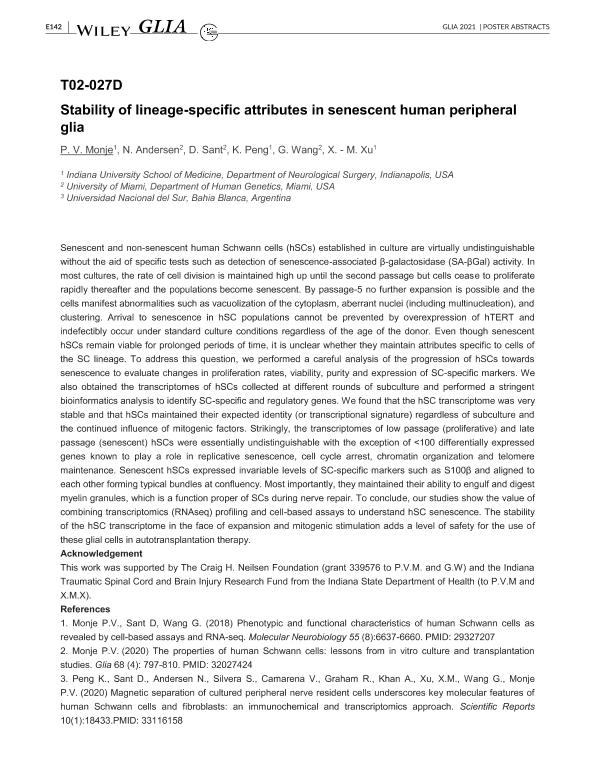Mostrar el registro sencillo del ítem
dc.contributor.author
Monje, Paula

dc.contributor.author
Andersen, Natalia Denise

dc.contributor.author
Sant, David
dc.contributor.author
Peng, Kevin
dc.contributor.author
Wang, Gaofeng
dc.contributor.author
Xu, Xiao-Ming
dc.date.available
2023-07-28T13:55:51Z
dc.date.issued
2022
dc.identifier.citation
Stability of lineage-specific attributes in senescent human peripheral glia; XV European Meetingon Glial Cells in Health and Disease; Marseilles; Francia; 2021; 25-25
dc.identifier.issn
0894-1491
dc.identifier.uri
http://hdl.handle.net/11336/205961
dc.description.abstract
Senescent and non-senescent human Schwann cells (hSCs) established in culture are virtually undistinguishable without the aid of specific tests such as detection of senescence-associated β-galactosidase (SA-βGal) activity. In most cultures, the rate of cell division is maintained high up until the second passage but cells cease to proliferate rapidly thereafter and the populations become senescent. By passage-5 no further expansion is possible and the cells manifest abnormalities such as vacuolization of the cytoplasm, aberrant nuclei (including multinucleation), and clustering. Arrival to senescence in hSC populations cannot be prevented by overexpression of hTERT and indefectibly occur under standard culture conditions regardless of the age of the donor. Even though senescent hSCs remain viable for prolonged periods of time, it is unclear whether they maintain attributes specific to cells of the SC lineage. To address this question, we performed a careful analysis of the progression of hSCs towards senescence to evaluate changes in proliferation rates, viability, purity and expression of SC-specific markers. We also obtained the transcriptomes of hSCs collected at different rounds of subculture and performed a stringent bioinformatics analysis to identify SC-specific and regulatory genes. We found that the hSC transcriptome was very stable and that hSCs maintained their expected identity (or transcriptional signature) regardless of subculture and the continued influence of mitogenic factors. Strikingly, the transcriptomes of low passage (proliferative) and late passage (senescent) hSCs were essentially undistinguishable with the exception of <100 differentially expressed genes known to play a role in replicative senescence, cell cycle arrest, chromatin organization and telomere maintenance. Senescent hSCs expressed invariable levels of SC-specific markers such as S100β and aligned to each other forming typical bundles at confluency. Most importantly, they maintained their ability to engulf and digest myelin granules, which is a function proper of SCs during nerve repair. To conclude, our studies show the value of combining transcriptomics (RNAseq) profiling and cell-based assays to understand hSC senescence. The stability of the hSC transcriptome in the face of expansion and mitogenic stimulation adds a level of safety for the use of these glial cells in autotransplantation therapy.
dc.format
application/pdf
dc.language.iso
eng
dc.publisher
John Wiley & Sons

dc.rights
info:eu-repo/semantics/openAccess
dc.rights.uri
https://creativecommons.org/licenses/by-nc-sa/2.5/ar/
dc.subject
SCHWANN CELLS
dc.subject
SENESCENCE
dc.subject
TRANSCRIPTOMICS
dc.subject.classification
Otras Ciencias Biológicas

dc.subject.classification
Ciencias Biológicas

dc.subject.classification
CIENCIAS NATURALES Y EXACTAS

dc.title
Stability of lineage-specific attributes in senescent human peripheral glia
dc.type
info:eu-repo/semantics/publishedVersion
dc.type
info:eu-repo/semantics/conferenceObject
dc.type
info:ar-repo/semantics/documento de conferencia
dc.date.updated
2023-06-15T18:05:52Z
dc.identifier.eissn
1098-1136
dc.journal.volume
69
dc.journal.pagination
25-25
dc.journal.pais
Francia

dc.journal.ciudad
Marseilles
dc.description.fil
Fil: Monje, Paula. Indiana University. School of Medicine; Estados Unidos
dc.description.fil
Fil: Andersen, Natalia Denise. Consejo Nacional de Investigaciones Científicas y Técnicas. Centro Científico Tecnológico Conicet - Bahía Blanca. Instituto de Investigaciones Bioquímicas de Bahía Blanca. Universidad Nacional del Sur. Instituto de Investigaciones Bioquímicas de Bahía Blanca; Argentina. University of Miami; Estados Unidos
dc.description.fil
Fil: Sant, David. University of Miami; Estados Unidos
dc.description.fil
Fil: Peng, Kevin. Indiana University. School of Medicine; Estados Unidos
dc.description.fil
Fil: Wang, Gaofeng. University of Miami; Estados Unidos
dc.description.fil
Fil: Xu, Xiao-Ming. Indiana University. School of Medicine; Estados Unidos
dc.relation.alternativeid
info:eu-repo/semantics/altIdentifier/url/https://onlinelibrary.wiley.com/doi/epdf/10.1002/glia.24050
dc.relation.alternativeid
info:eu-repo/semantics/altIdentifier/url/https://onlinelibrary.wiley.com/doi/epdf/10.1002/glia.24036
dc.conicet.rol
Autor

dc.conicet.rol
Autor

dc.conicet.rol
Autor

dc.conicet.rol
Autor

dc.conicet.rol
Autor

dc.conicet.rol
Autor

dc.coverage
Internacional
dc.type.subtype
Reunión
dc.description.nombreEvento
XV European Meetingon Glial Cells in Health and Disease
dc.date.evento
2021-07-05
dc.description.ciudadEvento
Marseilles
dc.description.paisEvento
Francia

dc.type.publicacion
Journal
dc.description.institucionOrganizadora
European Glial Meeting
dc.source.libro
Poster abstracts
dc.source.revista
Glia

dc.date.eventoHasta
2021-07-09
dc.type
Reunión
Archivos asociados
